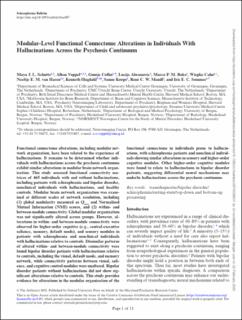| dc.description.abstract | Functional connectome alterations, including modular network organization, have been related to the experience of hallucinations. It remains to be determined whether individuals with hallucinations across the psychosis continuum exhibit similar alterations in modular brain network organization. This study assessed functional connectivity matrices of 465 individuals with and without hallucinations, including patients with schizophrenia and bipolar disorder, nonclinical individuals with hallucinations, and healthy controls. Modular brain network organization was examined at different scales of network resolution, including (1) global modularity measured as Qmax and Normalised Mutual Information (NMI) scores, and (2) within- and between-module connectivity. Global modular organization was not significantly altered across groups. However, alterations in within- and between-module connectivity were observed for higher-order cognitive (e.g., central-executive salience, memory, default mode), and sensory modules in patients with schizophrenia and nonclinical individuals with hallucinations relative to controls. Dissimilar patterns of altered within- and between-module connectivity were found bipolar disorder patients with hallucinations relative to controls, including the visual, default mode, and memory network, while connectivity patterns between visual, salience, and cognitive control modules were unaltered. Bipolar disorder patients without hallucinations did not show significant alterations relative to controls. This study provides evidence for alterations in the modular organization of the functional connectome in individuals prone to hallucinations, with schizophrenia patients and nonclinical individuals showing similar alterations in sensory and higher-order cognitive modules. Other higher-order cognitive modules were found to relate to hallucinations in bipolar disorder patients, suggesting differential neural mechanisms may underlie hallucinations across the psychosis continuum. | en_US |

